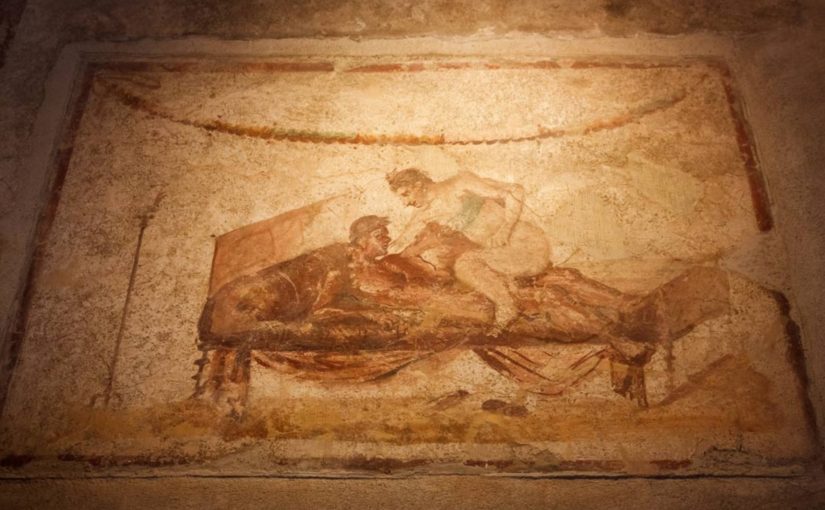I’ve been devoting more than enough time about the current Geo-political events around the world lately. I’ve posted some stuff about MAJestic and “Alien Interview” and some other stuff. But now, I want to breathe some life into some of my historical articles.
Ancient Rome has always fascinated me. As it was an empire that grew and collapsed by the massive internal corruption of it’s leaders and their inability to adapt to a changing world. But it is more than that. I am fascinated with the personal stores and histories of the people who lived then.
Not just Rome, but Greece, and many others.
In fact, I loved the fashion and clothing of the period and I had books on Roman fashion, clothing, furniture and all the rest. Once, when my brother visited me in Boston he was amazed that I had such books, and he carted off a box load to his home to read at his leisure later on.
Today we will look at prostitution in ancient Rome.
And you know, it was a different time and a different place. Back in those days, going to a prostitute was similar to going through a drive-through to get a hamburger. It was no big thing.
It was not an issue.
Everyone did it.
Men, women, boys, girls…

There just weren’t any vice laws to control the population through their desires, and all the social prohibitions that society has been shackled with since the middle ages. And knowing that is liberating…
Liberating in a way that gives us insight. An insight that tells us that there are other ways of doing things. Other ways of living. Other ways of happiness, social interaction, and society.
And THAT is what we are going to talk about here.
We will start with the historical segment, and then end up with a Geo-Political article that discusses what happens (or what might happen) when a dominant cultural influence is displaced by other powers.
Paying for Services: Illicit Brothel Coins of Pompeii Show What’s on The Menu
From HERE.
Today, there is a strong, negative stigma surrounding the occupation of prostitution. It is often looked upon as “sinful”, “detestable”, and “shameful”—both for the prostitute and the participant. In ancient Rome, while everyone certainly had their own views of the practice, it was far more socially acceptable.
In fact, brothels were somewhat of a staple in vacation cities like Pompeii and Herculaneum. (Which is helpful for archaeologists, as both those sites remains “frozen” in time.)
These staples eventually grew to encourage their own form of coinage, called spintriae in the Medieval period (though this name is misleading in ancient records). The prevalence of prostitution in Roman culture is highlighted through the wide circulation of these coins, and the plethora of imagery in the aforementioned vacation sites in southern Italy.
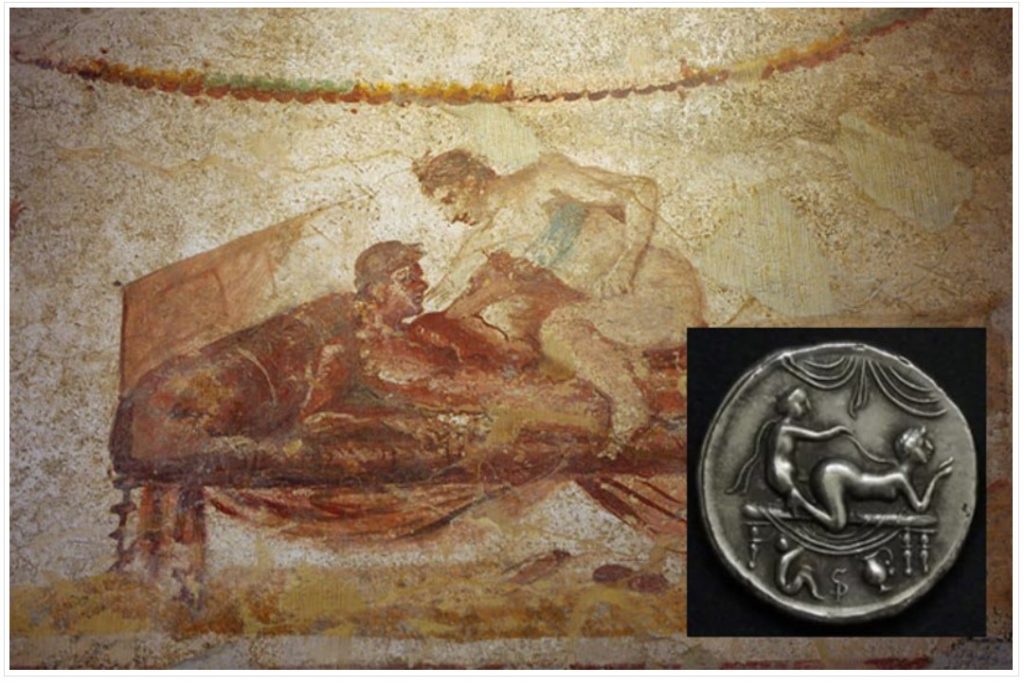
Ancient Sex Tokens – A Different Kind of Coinage
Roman brothel tokens were rather obvious to the everyday money-handler. The token had various sexual acts depicted on both the front and rear of the coins, usually the participants on the coin in the act of intercourse. Some depicted phalluses instead, full-formed and often with wings attached, likely indicating the virility of the man using the coin. While male prostitutes and female participants were not uncommon, it was far more common—as far as literature can tell—that wealthy males sought the company of a meretrix, or legal female prostitute.
It is also notable that the tokens predominately depict male-female relations rather than relations of the same sex, likely indicating that homosexuality (at least outward homosexuality ) had become far less acceptable by the time of the Romans than it was for their predecessors in ancient Greece.
One of the most prominent theories about the creation and purpose of the coins was to advertise the prices of sexual acts. Further, in passing a coin between two people—i.e., the buyer and the “seller”—one could maintain a level of privacy. This would have been particularly important to those of high status who did not want their late night dalliances known. It is believed by some scholars that “the sex act depicted on each coin corresponds to the price listed on the opposite face,” which has also been considered clever as it is “a system that would also have helped dissolve language barriers”.
If this theory is true, then one must consider that the coins themselves were not forms of payment; rather, they were more akin to calling cards or order slips. As one would say, “I would like a number 4” at McDonald’s and pay for their food at the window, an ancient Roman would pass the token and then subsequently pay for the service before or after it occurred.
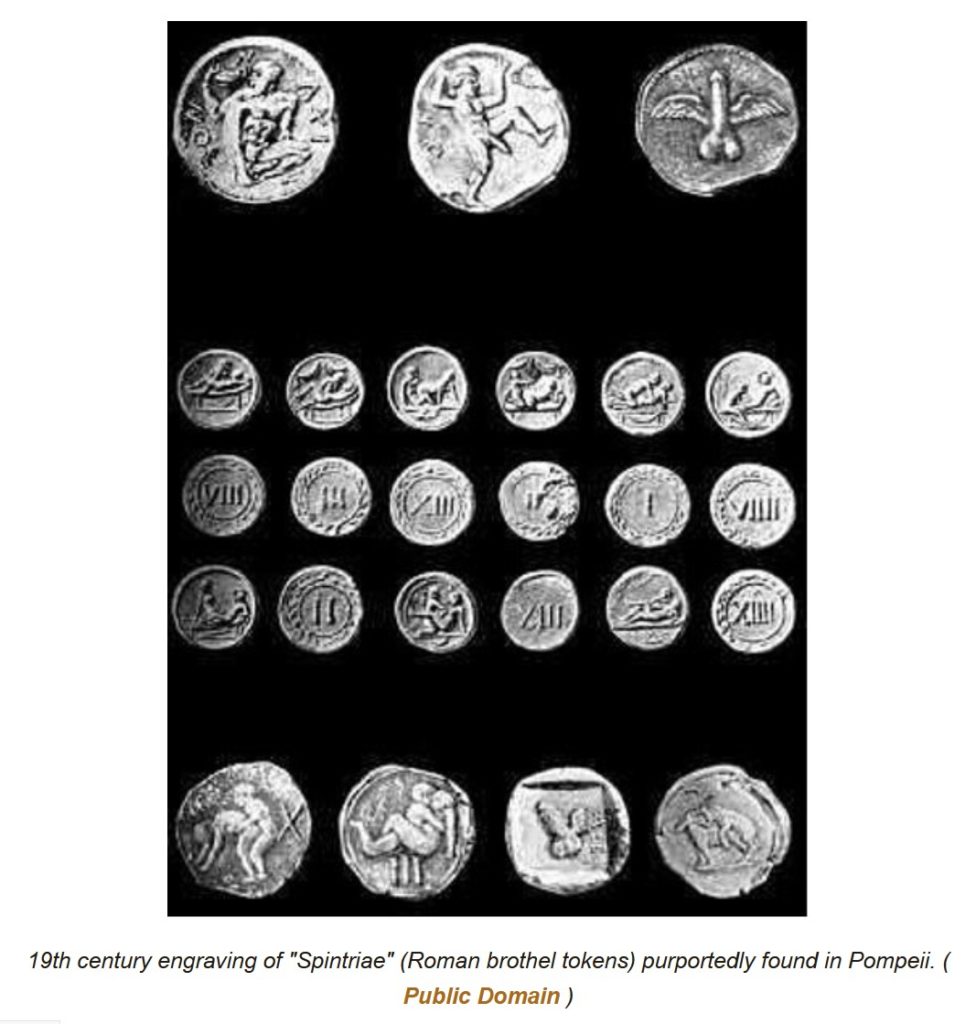
A more recent find of a Roman brothel token in London, called the “Putney token” for the bridge it was found near, was examined in 2012. As it is known the Romans had forts, camps, etc. in ancient Britain, the theory that these coins were used to get around language barriers is furthered. Britain’s Romanization was slow, thus so was the spread of the Roman language; however, an image of sexual intercourse is universally understood.
Were the Tokens an Early Form of Payment?
It is possible that these tokens were at some point used as a form of payment. Despite circulating only in brothels and between buyers and sellers, there is an indication that it would have been in the participants’ best interests if the coins were worth something. Cassius Dio, a Roman historian in the 3rd century AD, recounts one tale during the reign of Caracalla in which a coin bearing the face of the emperor was used in a brothel. This was seemingly seen as an insult to the emperor, and the man who used the coin was sentenced to death:

Granted, Caracalla has been described as one of the more temperamental emperors of the Roman Empire and perhaps reacted far more angrily than another emperor in this position would have; yet this tale indicates the that it might be best to keep sexual favors and imperial coinage separate from one another.
A Different Perspective
Prostitution was far more of an acceptable “career choice” (it wasn’t necessarily a choice) in ancient Rome than many believe; the current stigma of prostitution has damaged the reputation of what many consider the oldest occupation in history. Roman historians Livy, whose History of Rome is comprehensive, and Tacitus, credited as one of the better surviving sources of Roman culture and war, both dictate that prostitutes often had positive reputations, and often came from good families.
Emperor Augustus encouraged the occupation, making it “neither illegal nor stigmatized in ancient Rome, and in fact it was not unusual for an independent-minded upper-class woman to become a courtesan; when Augustus decided to encourage reproduction in the upper classes by taxing unmarried adult patricians, many women registered as whores so as to avoid being forced to marry.” (McNeill)
Thus, one should be careful about putting one’s own cultural perspectives on the ancient position, as the influx of Roman tokens found only furthers the reality that prostitution was a highly respected field for a long time.
The Lupanare: Prostitution and Houses of Pleasure in Ancient Pompeii
From HERE.
Mad emperors, fierce warriors, brutal entertainment, and lascivious lifestyles. These are the familiar images of ancient Rome, but what was it really like? Rumors abounded regarding Roman emperors and their indulgence in the pleasures of the flesh. Tiberius, for instance, is said to have indulged in secret orgies in his pleasure villa on the island of Capri. But until the 16th century discovery of the buried city of ancient Pompeii, the guilty pleasures of the Romans had been mostly hidden from the pages of history.
Ancient Pompeii: Roman Life Frozen in Time
Pompeii is a 6th century BC Roman city frozen in time, preserved by the layers of ash that spewed out from the eruption of Mount Vesuvius in 79 AD. Although Pompeii was initially rediscovered at the end of the 16th century, it was only properly excavated in the 18th century. This was due to the fact that excavators were startled by the sexually explicit frescoes they were frequently unearthing; something quite shocking to the sensibilities of Medieval citizens of Rome, so they quickly covered them over.
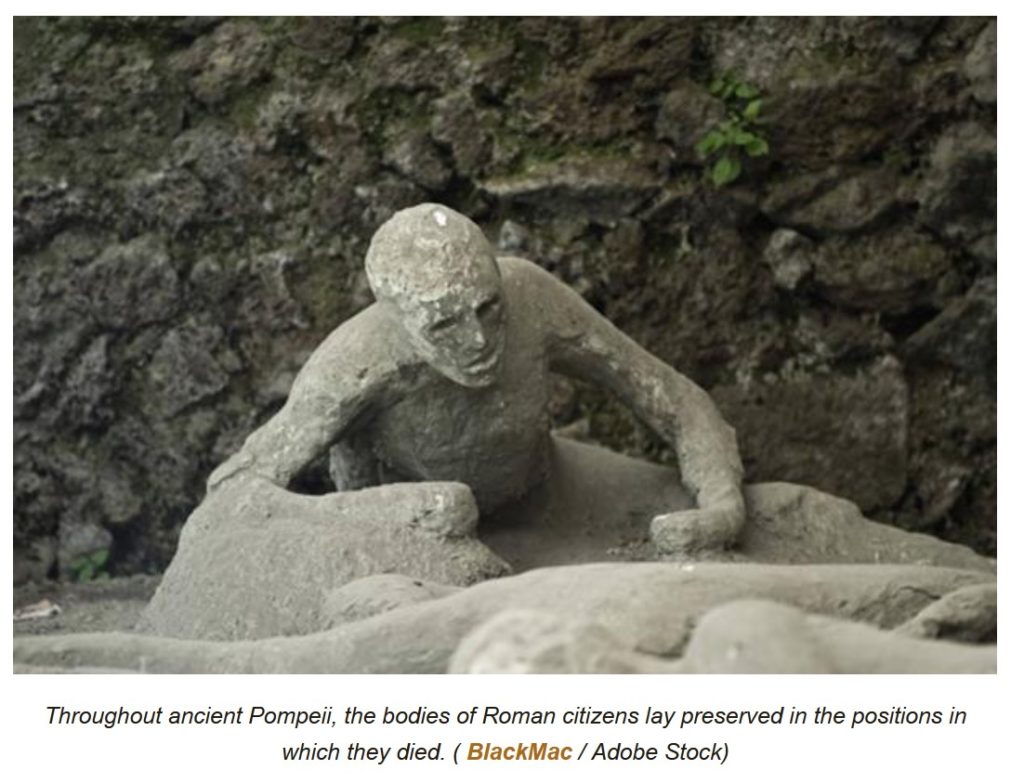
When excavations resumed nearly two centuries later, archaeologists found a complete city almost entirely intact. Loaves of bread still sat in the oven, bodies of men, women, children, and pets were found frozen in their last moments, fear still etched onto their faces, and the remains of meals were found discarded on the pavement. The astounding discovery meant that researchers could piece together exactly what life was like for the Romans of ancient Pompeii: the food they ate, the jobs they performed, the houses they lived in, and of course, the activities they engaged in for pleasure.
Discovering the Carnal Pleasures of the Romans in Ancient Pompeii
Excavators unearthed evidence of numerous brothels in the ancient city of Pompeii, as determined by the discovery of both erotic frescoes and graffiti adorning the walls of buildings containing several rooms with stone beds. The phallus was a very common decoration for good luck in Pompeii and it was painted in the houses, streets, and shops.
One of the famous brothels in ancient Pompeii was called the Lupanare (Latin for wolf’s den). Now a UNESCO World Heritage Site, this was a two-story building built just years before the destruction of Pompeii. Believed to be the only purpose-built brothel in Pompeii, the Lupanare had ten rooms and a latrine under the stairs.
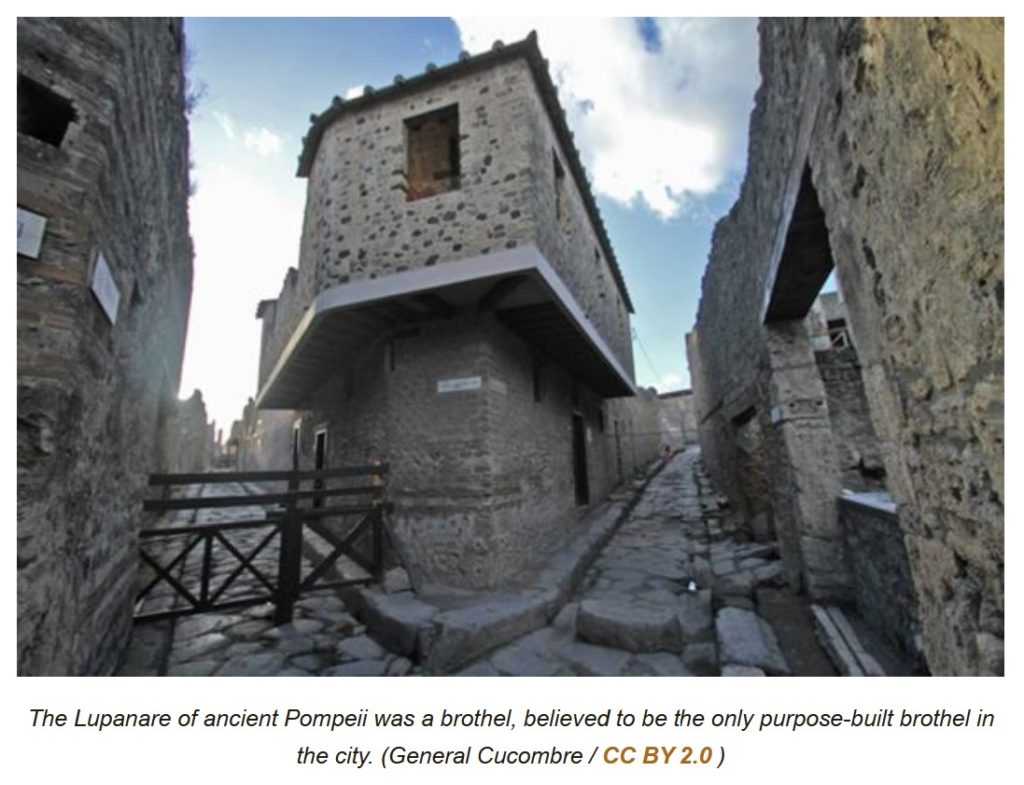
Each of the ten rooms had a stone bed covered with a mattress where a prostitute would entertain her clients. Another famous feature of the Lupanare is its erotic wall paintings. Each of the paintings depicts a different position for sexual intercourse , and these are believed to have served as an advertising board for the various specialties that were on offer.
Despite the erotic nature of these images, it has been suggested that they were merely an idealized version of sex. To regard them as a representation of the actual transaction would be tantamount to regarding contemporary pornography as the real thing. Thus, it has been postulated that the lives of the prostitutes at the Lupanare was far grimmer than the erotic images suggest.
The chambers where the prostitutes worked were windowless, cramped, and uncomfortable places separated from the anteroom only by curtains. Furthermore, it has been suggested that most of the prostitutes in Pompeii were slaves of Oriental or Greek origin. As they were involved in the slave trade and not trained in other professions, it seems that these women had no real alternatives for work. In the CBC program The Nature of Things , Dr. Kelly Olson, a professor of classical studies, visits the Lupanare and claims “it’s not a very nice place to work.”

Their clients, however, seem to have had a better time at the brothels, as demonstrated by the graffiti that they left behind. There are over 100 inscriptions on the walls of the Lupanare. One inscription, for instance, runs simply as such: “I screwed a lot of girls here.”
Another inscription even records the date that the person visited the Lupanare, “On June 15th, Hermeros screwed here with Phileterus and Caphisus.” The wealthier members of society generally did not visit brothels, as they were able to afford mistresses or slave concubines. Thus, it is more likely that those who frequented the brothels of Pompeii and left the graffiti behind were ordinary Romans.
Interestingly, the clients of the Lupanare also left notes on the wall that allowed archaeologists to work out the prices of the services provided there. It seems that two loafs of bread and half a liter of wine would enable a person to obtain the services of a prostitute. Needless to say, the fees were paid to the brothel owner, rather than the prostitutes themselves. Such is the life of a prostitute in a brothel of Pompeii, as far as the archaeology is able to tell us.
The Lupanare was first excavated by Giuseppe Fiorelli in 1862 and it was during this work that the archaeologists discovered the now almost 2,000-year-old erotic panels on the ground floor of the brothel. The frescos and other sexual objects created by ancient Romans and discovered in the ruined city have been the subject of much contention. The explicit frescos for example were covered, and some claim that up until the 1960s only male visitors were allowed to view them for an additional fee. The ancient brothel was restored and opened to the public after an investment of $253,000.
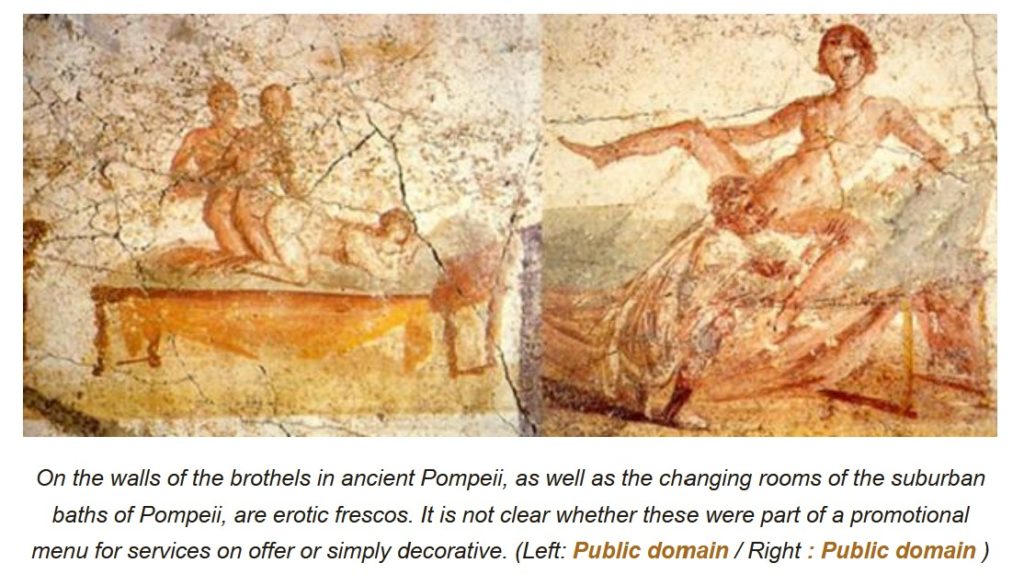
Deemed as scandalous at the time of their excavation, many of the more erotic objects discovered in ancient Pompeii were removed and taken to the Naples National Archaeological Museum. They were placed in the Gabinetto Segreto (the so-called “Secret Cabinet”), which was founded by Frances I, the King of Naples, who decided that certain explicit images were to be seen only by “people of mature age and respected morals.” It was only opened to the public in 2000.
These days, the restored Lupanare is open for tourists to explore and learn about prostitution in ancient Pompeii . According to the Daily Mail , several tourists have even tried to relive the sexual antics of the Romans, breaking into the brothel or the suburban baths “to fulfil their fantasies.”
The Grim Reality of the Brothels of Pompeii
From HERE.
Like the anxious men who began excavations at Pompeii in the 18th century and discovered more about the ancient Italians than they had bargained for – such as phallic-shaped lamps – historians of sex are regularly confronted with case studies from the past that challenge their own ethics. Those who worked the streets of Pompeii and served clients in the brothels lived hard lives, yet many of the murals that survive depict the women as erotic and exotic.
Murals from brothels and buildings that served as brothels (such as inns, lunch counters, and taverns) show fair-skinned women, naked (except for the occasional breast band), with stylized hair, in a variety of sexual positions with young, tanned, athletic men. The figures sport on beds that are sometimes ornate and festooned with decorative quilts.
In buildings identified as brothels, the murals may have been intended to arouse clients. They may also have functioned as pictorial menus or even served as instruction manuals for more inexperienced customers. In buildings identified as private residences, the scenes were most likely decorative but also designed, perhaps, for titillation.
Contrary to the idealized images, the brothels themselves provide evidence that the women worked in cells, usually only big enough for a narrow bed. The absence of windows in most attests to the darkness of the cells, as well as limited air flow.
Excavations also suggest that the cells were usually without doors, which implies that the rooms may have been curtained. They have also revealed stone beds. Wooden beds as well as pallets were likely also used, but would have perished in the eruption of Mount Vesuvius in AD 79.
The conditions in which the women worked were of no concern to brothel owners, clients or anyone else for that matter, as most sex workers in ancient Italy were slaves. As the ancient attitude towards slaves was one of indifference at best, and violent disdain at worst, the lives of women were no source of empathy to those outside their class.
The sex workers fulfilled a utilitarian function and nothing else. Confined to the premises by (usually) male pimps who provided them with only their most basic needs, the women were essentially cut off from the outside world. This rendered them vulnerable to the whims of both pimp and client alike.
Women who worked the streets in Pompeii often waited around archways and other standard locations such as graveyards and public baths. In larger towns and cities, where control of the sex trade was harder to manage, some of these women may have worked without pimps. Those who made up this percentage of workers were mostly freed slaves and poor freeborn women.
Stories From Graffiti
The preservation of graffiti on the walls of Pompeii’s buildings also provides historians with details of the sex trade. Most of it is extremely graphic. It includes information on specific services and prices, clients’ appraisals of certain women and their abilities (or lack thereof), and some sexual advice.
Some graffiti are straight to the point:
Thrust slowly
Others are advertisements:
Euplia was here with two thousand beautiful men
Or a list of prices for various services.
Often the names of slaves and, by default, sex workers, had Greek origins. The name “Euplia”, for example, comes from a Greek word meaning “fair voyage”. Sex workers’ names sometimes denoted the function or physical features of the individual in question. In this case, Euplia promised her clients a fair voyage.
Graffiti also attests to male sex workers in Pompeii. As with the writings concerning women, this graffiti lists specific services offered and sometimes prices. As freeborn women were not permitted to have intercourse with anyone but their husbands, the clients who accessed male sex workers were almost exclusively men. The sexual mores of ancient Rome, catered for male-to-male sexual encounters if certain protocols were maintained (a citizen could not be penetrated, for example).
The few literary records that suggest there may have been female clients of sex workers are questionable, as they were usually written for satiric or comedic purposes. Still, it would be naïve to discount instances of wealthy, freeborn women accessing male sex workers or household slaves.
Similarly, it would be naïve to assume that male clients did not seek other men with whom they could participate in acts deemed socially unacceptable (essentially acts in which the citizen male would occupy a submissive role).
Society and the Sex Trade
At the time of the eruption of Vesuvius, Pompeii was a town of modest size, with a population of around 11,000, and a thriving community with sophisticated architecture and infrastructure. Located in Campania, some 23 kilometers southeast of Naples, and near the port of Pozzuoli, it enjoyed robust trade and economy, and had a multicultural demographic.
The prosperity of the town and the continual presence of merchants ensured a strong market for sex. Indeed, the sex trade was integral to the successful functioning of society, particularly marriages.
As marriages, particularly those among the elite classes, were arranged and predominantly for the birth of male heirs, a husband would not seek sexual pleasures from his wife. Rather, out of respect for her, a man would pay for pleasurable sex, especially those acts that were not expected to be performed by a respectable woman.
Indeed, the graffiti attests to five different types of sex for sale: intercourse, cunnilingus, fellatio, active anal sex, and passive anal sex. Thus the sex trade performed a type of social and moral policing of the institution of marriage, as well as the preservation of an adult male’s reputation and masculinity. As sex work was not illegal (being predominantly structured around slavery) but adultery was outlawed, this was another reason for paying for sex.
The layers of volcanic materials that covered Pompeii and most of its population to a depth of 25 meters (82 feet) left extensive evidence of the ancient Italians, their lifestyles, and their environments. Ironically, the eruption that trapped the inhabitants in both time and place has bestowed a strange immortality upon them.
These people whisper to us, and their tales are varied, joyous and sad. Their stories are sometimes shocking and even heartbreaking, but, like the lives of the sex workers, worthy of remembrance.
The Graveyard Prostitutes of Rome and Beyond
From HERE.
Ancient regulars of the world’s oldest profession may have grown bored with the “usual” items on the coitus menu. That may be why ancient Rome enjoyed a thriving sexual ecosystem with robust variety and a market for all kinds of Roman prostitutes. Yet the dynamic sexual menu, made infamous from excavations at Pompeii, is given little to no mention in history, particularly when it comes to the Bustuaries or graveyard prostitutes.
he cemetery or graveyard prostitute is an intriguing vocation within the sex trade of the era. But don’t assume that graveyard prostitutes were an archaic hedonistic niche desire, of interest to only the most degenerate Romans. After all, graveyard prostitutes continued well into the modern era, in trying times such as the Covid-19 pandemic. This begs questions as to the allure of combining lust and death in sexual practice. Perhaps studying the history of the Roman Bustuarie, we can find some answers.
Prostitution in Rome: The Hierarchy of Roman Prostitutes
According to many scholarly sources, by the first century AD Rome was home to a thriving economy of 32,000 legally registered sex workers, along with additional slaves being sold into the sex trade almost every day. Those sold into slavery began either as children or pre-teens, who were then made to solicit and rapidly learn the ways of pleasuring.
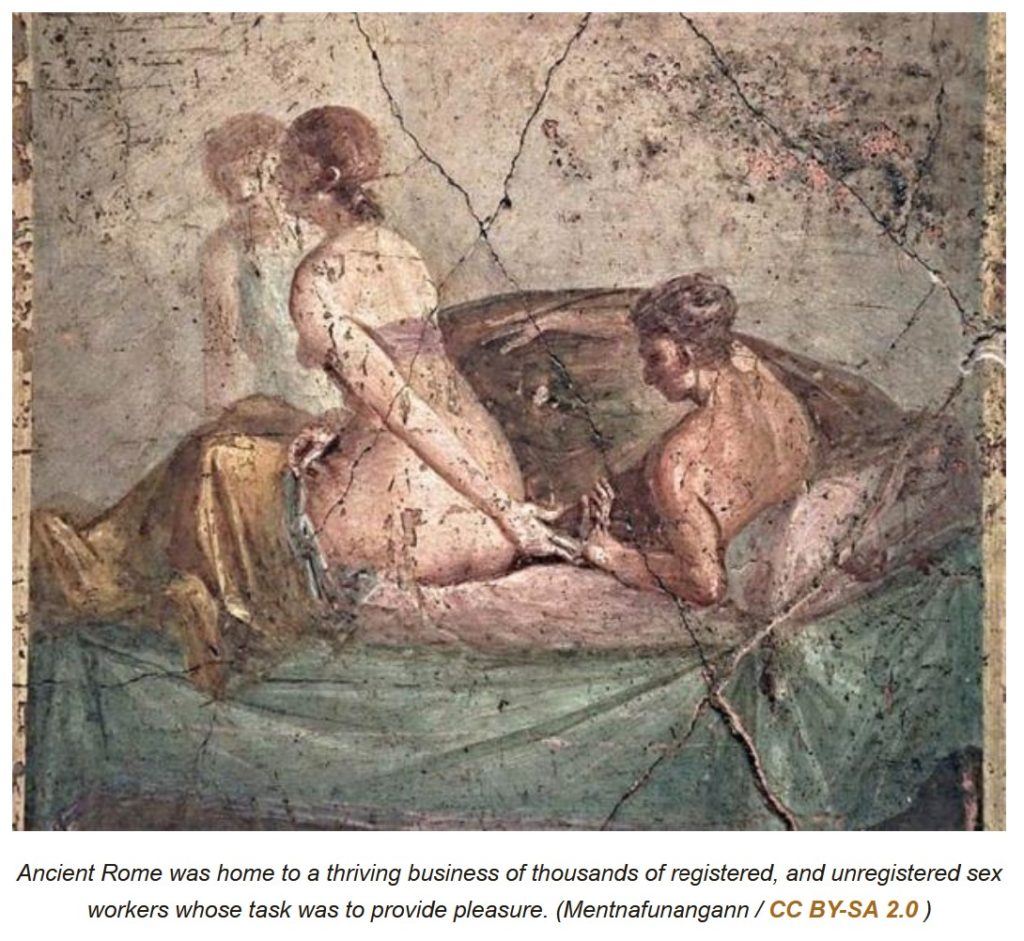
But not all Roman prostitutes were slaves. There were a small number of registered voluntary citizen sex workers acting on their own accord. In other instances, despicable men would force their daughters, wife, or sisters into prostitution to gain extra income; however, this particular act would later be made illegal by legal decree under the rule of Theodosius the Great. As of that point, all men found guilty of soliciting family members would lose legal custody.
Of the registered prostitutes, the upper Roman patrician class’s most elite sex workers were known as the high courtesan Delicatae. Even the delicious Delicatae, who were seductive rebellious daughters from upstanding patrician families, hoped to bring shame and scandal to their elite familial name. Though the Delicatae were usually masked, and therefore protected from being recognized, the fact remained; they existed to those who knew where to find them.
Other forms existed in temple cults dedicated to Isis, Ceres, Magna Mater, Venus, and Pax. For those who were of the Roman lower castes, most registered prostitutes could be found in local, dingy, and unventilated brothels, steamy bathhouses, and even taverns mediated by pimps. Even with these many venues of operation, other variations of prostitute existed for those looking for something cheap, if not a little dicey.
Besides the broad range of registered Roman prostitutes on offer, there were also unregistered free agents known as Prostibulae. Made up of unregistered prostitutes, these were usually self-employed freed slaves or extremely poor women who avoided paying heavy roman taxes by any means necessary.
Some became known as Ambulatae, who were unclean, provincial streetwalkers, waiting outside or near to the high-priced brothels, gladiatorial arena venues, theatres, and circuses ready and willing for just two pieces of coin. The Ambulatae would not have the same alluring erotic candles or signs to point customers their way. Instead, they relied on revealing garments, and if they were lucky, erotic cookies in the shape of penises to advertise their services.
Dark Desire: The Bustuarie Graveyard Prostitutes
For those who were too timid to approach the Ambulatae, there was always the option of an encounter with a Bustuarie cemetery prostitute, the lowest of the low on the hierarchical scale of Roman prostitution. Bustuarie prostitutes mainly operated within the graveyards and underground tombs of Rome. They were described as shameful, gaunt, pale, and sickly, all descriptions akin to the dead themselves. In the early morning, they offered their services as mourners for hire, but by night they were ready to fulfil any dark desire.
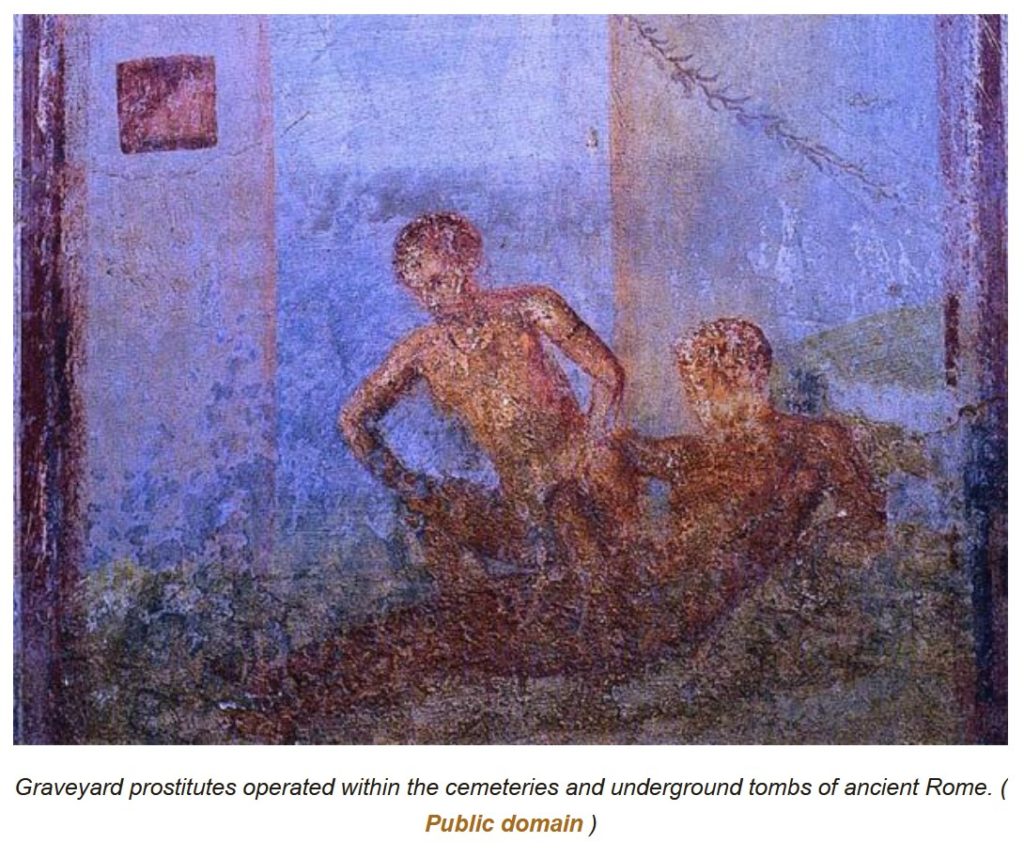
The Bustuarie used chalk on the backs of headstones to advertise their prices, and engaged in sexual acts within tomb passages and secluded plots. Graveyard prostitutes could be found throughout the Roman Empire, and even in the outskirts of Londinium (modern-day London). Their clientele was made up of grave diggers, eager pseudo-necrophiliacs and vulnerable mourning widowers. They were exquisite navigators in finding the emptiest of mausoleums, the softest of burial plots, and even the cold slabs of tombstone that presented an opportunity for intimate discretion.
There were even stories of fair-skinned women resting on ancient tombs with gold coins upon their eyes, not as a payment to the ferryman to cross into the underworld, but payment by the God Orcus for her lustrous services. With a reputation for sexually satisfying the God of the underworld, the Bustuarie were able to provoke the interest of any young Roman wishing for an experience bordering the boundaries of death and love. However, what of precaution and disease when in the presence of a prostitute surrounded by death?
Safe Sex? Hygiene Amongst Roman Prostitutes
Prostitutes, registered or not, were still treated as slaves, and once someone had been associated with employment in the sex trade, their fate was sealed. Within the world’s oldest profession, life would forever be a struggle for survival rather than an adventure filled with the thrills of carnal desire. The living conditions alone made the ancient life of prostitution disease-ridden, painful, and extremely uncomfortable. Even with such inhumane conditions, there were still cultural customs within the sex trade of Rome.

In the brothels throughout the Roman Empire, it was very common for the rooms to be small, windowless, and penetrated with the stench of purchased intimacy. The only light would come from phallic-shaped candles, used to indicate when a prostitute was ready for her next client. More often than not, water boys would stand outside the brothel rooms readying their bowl for the finished clients to clean themselves after payment was given.
In the ancient world, brothels were known to have their own water mains, allowing prostitutes to clean themselves in between clients. However, their water rations would only allow for cleaning their essentials rather than their entire bodies. The prostitutes, such as the cemetery Bustuarie, were given no such luxuries. They were expected to guarantee satisfaction for their clients from dusk until dawn, and would then await their turn at the public bathhouses only if they had made enough money to enter.
Though bathing was a luxury, the appearance of cleanliness was essential for maintaining clients in ancient Rome by way of scent, style of dress, and grooming. For those who didn’t have access to bathhouses or brothel water supplies, another option developed. While it didn’t help much when it came to hygiene, at least it created the delusion of cleanliness. The Bustuarie used perfume to mask the scent of death and stench of previous encounters.
Clothing, Fashion and Appearance: The Mark of a Roman Prostitute
Prostitutes had a particular look which made them stand out from other women. This distinction also aided in advertising their profession without saying a word. The brothel prostitutes or high-class elites wore very revealing green sleeveless tunics, along with green shoes to indicate that they were ready for clients. The wardrobe of a Roman prostitute also included blonde horsehair wigs decorated with golden chains or curls. Purple lingerie, revealing silks, flaunty golden jewel necklaces, bracelets, and very short attire, became popular in later periods of Rome as well. It was illegal for prostitutes to wear anything that resembled a long band since those were customary of dutiful married women to carry.
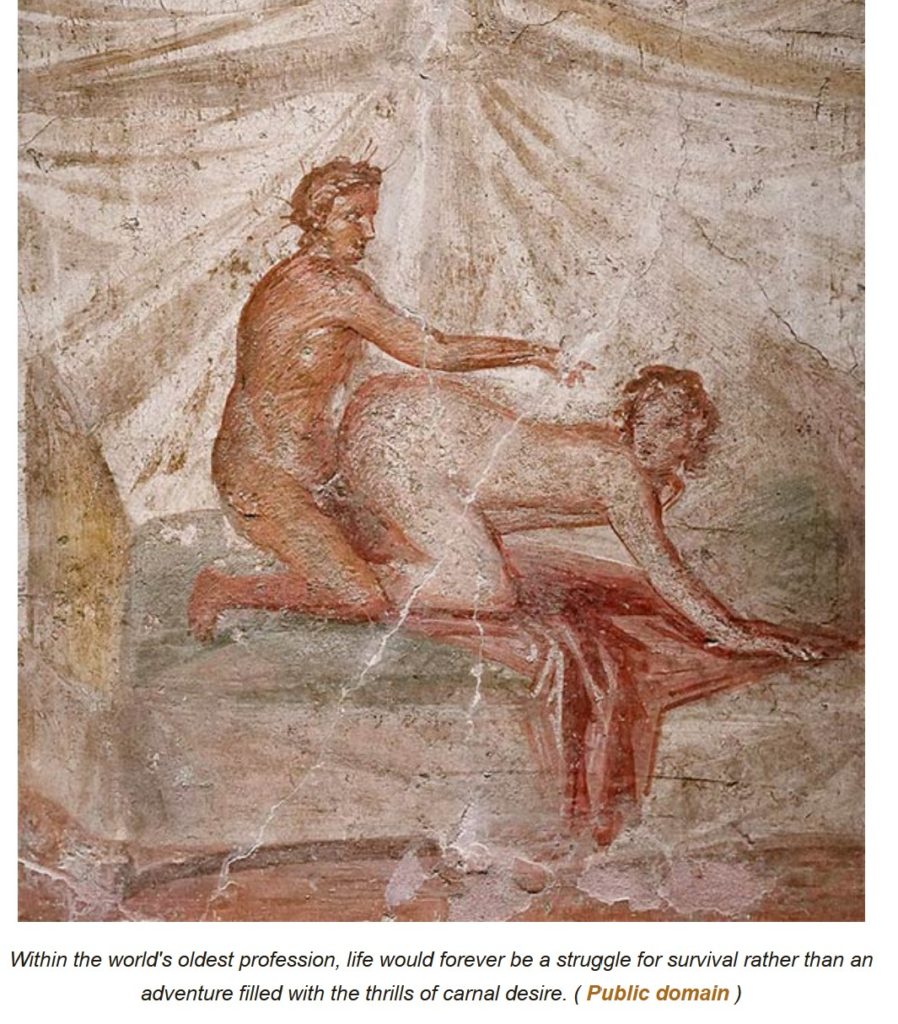
Also common for the ritual beautification of Roman prostitutes, was the use of makeup to redden cheeks and lips. They also practiced depilation, or the removal of unwanted pubic hair, by way of arsenic and burnt lime which painfully singed the hairs from the legs, armpits, and genital areas.
The lower caste of Roman prostitutes was usually naked or laden with belts made of straw to indicate their profession to the eyes of eager men. The cemetery Bustuarie was typically scantily clad, or just as naked as the streetwalkers of Rome. However, their appeal was in appearing as pale and as gaunt as possible. As mentioned before, many clients desired making love to corpses and found the Bustuarie the perfect way to fulfil their fantasy. When they performed the act, they would lay as still as possible and remain limp for their clients to indulge, before asking for payment.
The Financial Burdens of Prostitution
Along with the effort required to stay attractive and clean, the stresses of the continued pursuit of revenue forever loomed over prostitutes from every social class. By the second century BC, registered prostitutes had to carry permits to partake in the sex trade. In their application, they were required to list their current name, place of birth, age, and pseudonym to keep their family name anonymous.
In ancient Rome, any women who earned money independently was considered to either dabble in prostitution or be the manager of prostitutes. No matter what level in society a prostitute was, money was a significant part of their livelihood. With many registered prostitutes, heavy taxes were enforced, which essentially counted for a third of their daily income. If they did not report to the local tax collecting Aedile, they faced termination of their registration.
By 40 AD, Emperor Caligula alleviated the extreme taxation of prostitutes and the charge was reduced to the equivalent of one client per day. This reveals how profitable legalized prostitution was for the Roman Empire. Unregistered or independent prostitutes, including the streetwalkers and Bustuarie, it was necessary to nab at least two clients a day to subsist. One payment would go to a piece of bread, and the other to wherever they were staying, or to access to the local bathhouse. Without this, the Bustuarie would not be able to eat that day.
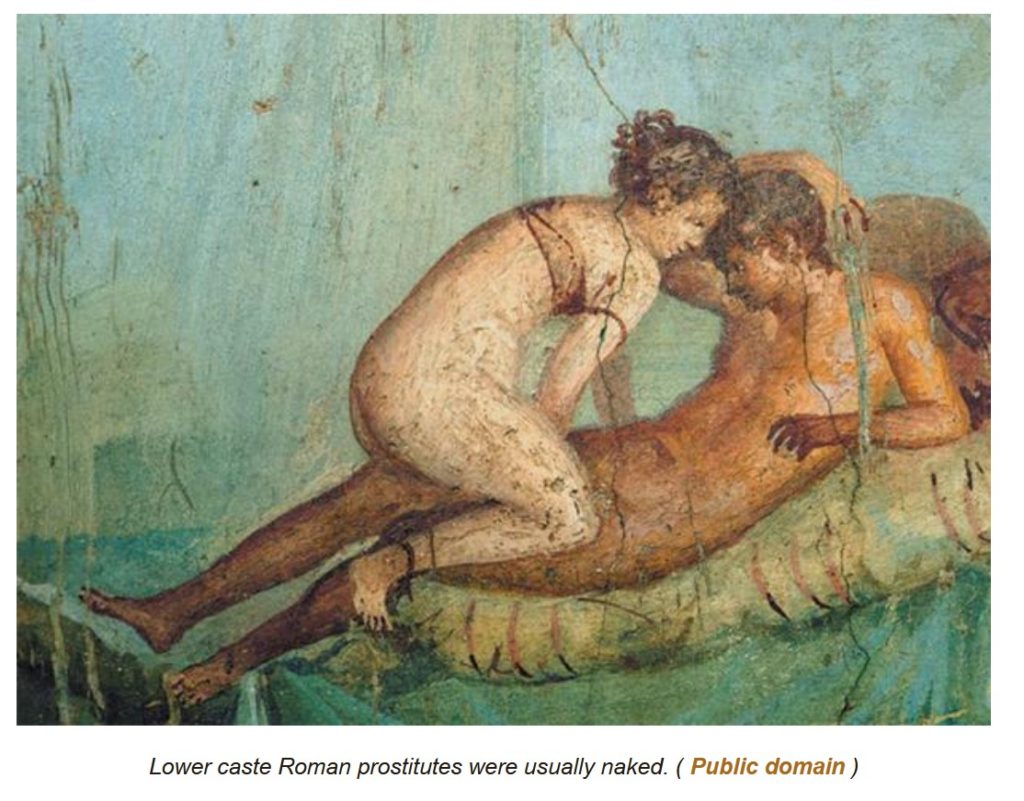
Unregistered prostitutes were in constant danger. While they were pursued by Roman tax collectors, they were admired for their resilience by both the people and select politicians. In ancient historic and literary accounts, prostitutes, no matter how rich or poor, were respected for their discretion, a code of honor which was highly regarded in Roman society.
Prostitution and Infanticide in Roman Times
Part and parcel of a lifestyle filled with allure and desire, was the concern of conception at any moment. Although the ancient world had developed certain contraceptives, becoming pregnant was very common amongst prostitutes, as was the practice of infanticide. In the current era, infanticide is rightly perceived as a negative and very unfortunate. However, in ancient Rome infanticide was completely up to the father. If the family’s patriarch dubbed the child unnecessary, he was in his legal right to dispose of the child, however he wanted. Often the reasons behind an act of infanticide were due to deformity, or, regrettably, if the child was a girl.
Roman prostitutes who were burdened with an unwanted pregnancy often killed their babies shortly after birth. The Yewden Villa excavations at Hambleden conducted in 1912 uncovered the remains of 87 babies. While the Leon Levy expedition to Ashkelon revealed the remains of 100 infants within the bathhouse sewers. These discoveries indicate the sheer indifference demonstrated as the human remains were found in waste piles next to dead animals and garbage. Analysis indicated that the children were murdered the day after they were born.
Infanticide was no stranger to the graveyard prostitute. Their unwanted children would have been abandoned in local garbage sites or left in the cold gutter near the roads leading to the graveyards. In other instances, unwanted children would be exposed or abandoned near to market places or crossroads to either perish or be adopted by others.

To the ancient Romans, infanticide was commonplace. It was viewed as an effective birth control method and was far less dangerous than abortion methods. However, not all unwanted children were killed immediately. In some instances, babies were kept alive until a certain age and then reared to become prostitutes themselves.
The brothels discovered in Pompeii revealed a significant difference in gender preference when practicing infanticide. The boys born of prostitutes were killed due to the danger that could come from the existence of illegitimate sons born from high-status Roman men. During Augustus and Claudius’s age, laws were put in place that ordered the death of any newly born bastard boys from prominent families. The law was put in place to assure a strong stance against adultery. At least in Pompeii, girls may have been spared from death since they could be sold into the slave trade or trained become prostitutes within thirteen years. In all other instances of infanticide, it appeared that babies were killed indiscriminately and without gender prejudice.
Graveyard Prostitutes after the Roman Empire
Although the attitudes towards infanticide and slavery may have changed, some cultural aspects regarding prostitutes and brothels have continued up until the present day, especially when it comes to graveyard prostitutes. Though the Bustuarie were considered the lowest and poorest of prostitutes, their popularity was far reaching throughout the empire and continued after its demise.
While culture and customs changed over time, the dark desire for fornication within gravesites grew ever more popular, reaching its peak during the Black Plague of Europe in the mid-1300s, an event which resulted in the death of almost half the population in certain European countries by 1360. Surrounded by death, the anxiety caused by the lack of any cure, and incessant praying for fear of God’s wrath, it appears that the surviving population was aroused by the idea of morbid acts of graveyard sex.
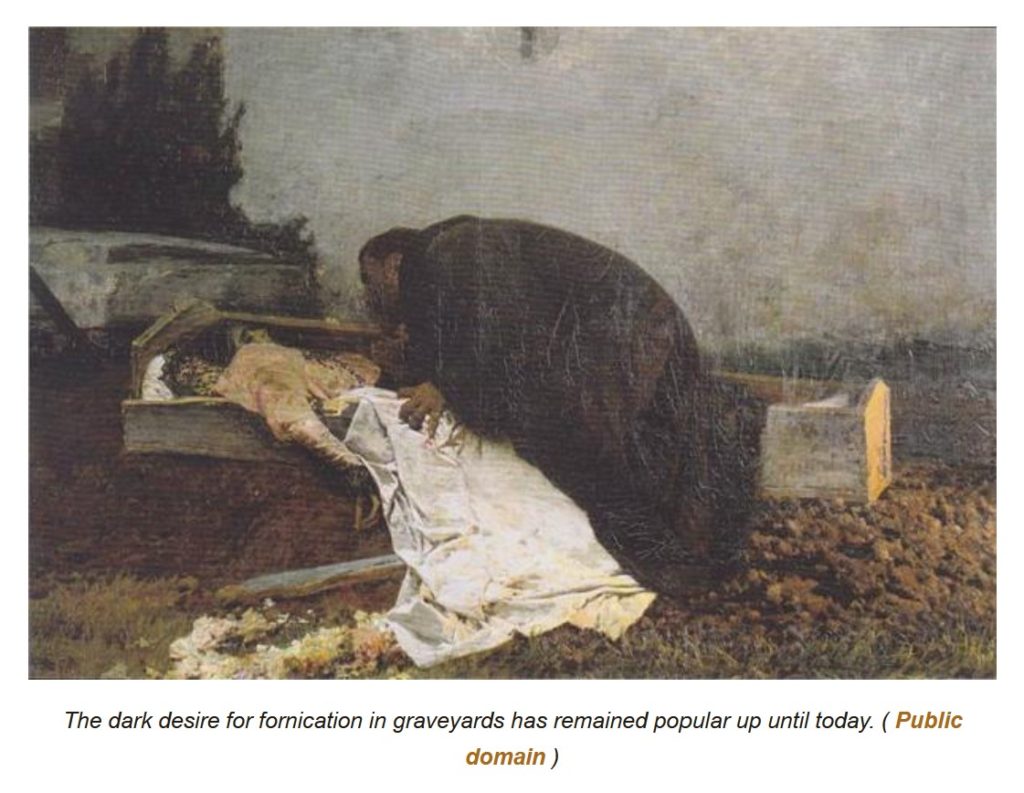
Amongst the piles of dead bodies, people would pay prostitutes to join them in death-defying orgies to celebrate life. This has been explained by scholars as a method of coping with the devastation inflicted by the Plague. The acts became so popular that in places like France, the Papal office decreed laws and ex-communication to anyone caught in morbid sexual act with any prostitutes near or in graveyard sites.
Since the papal office believed that sexual immorality was a key factor for the Plague, feared that continued sexual escapades within cemeteries would invoke further death. The act itself did take many lives, including the prostitutes who took advantage of the new-found demand. As many as two-thirds of working prostitutes perished, leaving very few in active service during those times. With such limited supply in the sensual sale of flesh, many authorities turned a blind eye so that others could enjoy prostitutes during the peak of infection.
Though Europe would eventually gain control over the spread of the Black Plague, the practice of graveyard prostitutes continued on and were very prominent in the 1940s, especially after the liberation of Naples. In many accounts, it was commonplace to see people having sex on gravestones. The reasons behind this sexual activity appear similar: after such immense death and devastation, it was time to celebrate the best of life by putting on a show for the dead. However, as the world currently endures the Covid-19 pandemic, are attitudes of the current millennial generation in tune with our European ancestors when it comes to sexual intercourse among graves? The answer is absolutely!
Since the global outbreak in 2020, there have been global reports of individuals having sex in graveyards. Many cases have occurred throughout England, raising concerns related to public indecency, the spread of Covid-19, and the desecration of church gravesites. As Watts reports, “the world’s oldest churchyard in Torquay is being used by people openly having sex and sunbathing nude in broad daylight.” Priests, such as the Roman Catholic Monsignor Arthur Coyle, were caught soliciting for sex at the Holy Trinity Polish Cemetery, in Boston Massachusetts, USA.
It would seem that even though the graveyard Bustuarie were the lowest of the prostitute caste system in ancient times, throughout the ages they have remained desirable and psychologically appealing, especially during times of world devastation. Is graveyard sex an act of moral defiance and social deviance in times of global unrest? Or, could it be that paying money for sex in front of the dead serves as a coping method for devastating loss?
Exposing the Secret Sex Lives of Famous Greeks and Romans in the Ancient World
From HERE.
In the ancient world, the public were not so privy to information about the scandalous sex lives of central societal figures. Still, sexual rumors have always existed and, in this way, historical figures became famous for their sexual exploits.
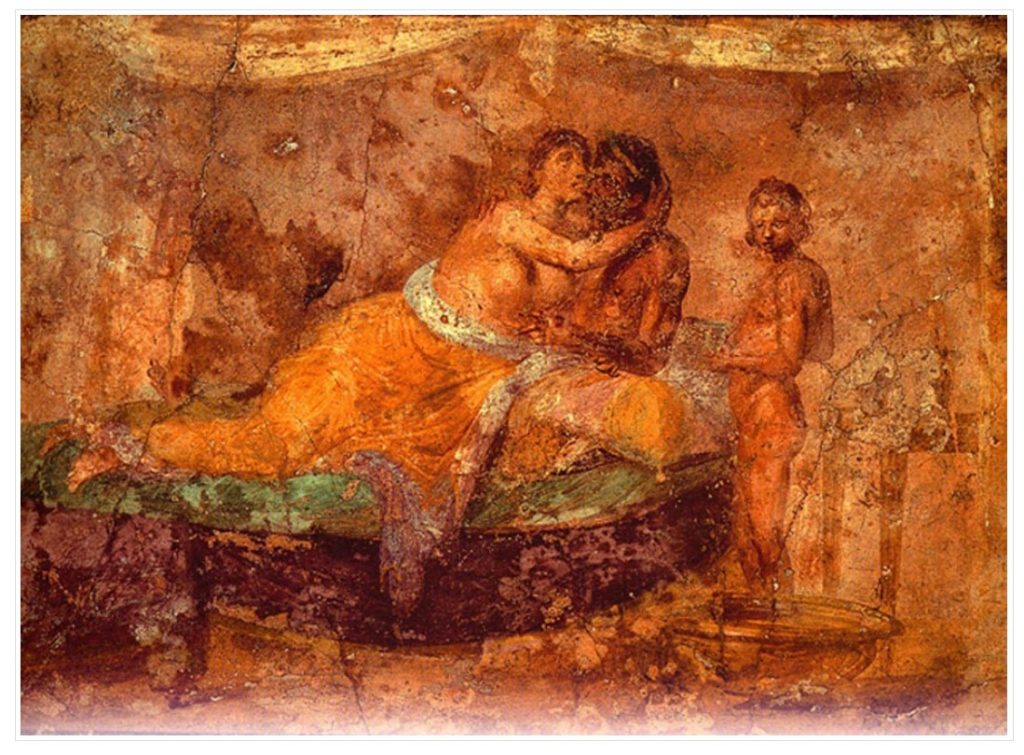
William the Third is rumored to have preferred men to women. Catherine the Great had many lovers and she reportedly gave them gifts even after the affair was over so that they might help her find her next man. The press ran pamphlets about Marie Antoinette’s sex life as well. She was rumored to have participated in orgies where she slept with her brothers-in-law as well as with other noblewomen. Genghis Khan is said to have been with so many women that today there are around 16 million of his living descendants. Julius Caesar liked both men and women and, in the case of men, his political enemies used to say that “He was every woman’s man and every man’s woman”.
Tiberius’ Twisted Sex Practices
Emperor Tiberius is regarded as one of the most sexually twisted rulers. He ruled between the years 4 and 37 AD and his biographer Suetonius stated that, in later life, the emperor had built himself a porn center on Capri. There, young people engaged in elaborate sexual acts both with Tiberius watching as well as with his participation. In the emperor’s bathing pools, the youths were trained to fellate him underwater while the old emperor called them “his little fishes”.
Speculations and Suspicions
Greeks and Romans had a relaxed attitude regarding nudity and they adored the human form. However, once a person died, the human body no longer posed any interest. As a result of this, their knowledge of detailed human anatomy was mostly based on speculation.
For example, there was a strange belief stating that women’s wombs vagabonded about the body causing hysteria. In order to treat this, doctors used bad smells along with loud noises to scare wombs back into position. There were also strange beliefs regarding the clitoris; a large clitoris was considered to be a medical condition requiring surgery.
Kissing in public was not seen as something positive in the Greek and Roman aristocratic circles. Still, husbands did kiss their wives when they returned home at night after having been to parties. The purpose of this was not affection. Instead, they used kissing in order to determine whether or not the woman had been drinking during the man’s absence. Kissing also lost popularity when Roman citizens from Spain began to brush their teeth with human urine.
Gladiators’ Scandalous Sex Lives
Many well-known gladiators also had scandalous sex lives. They were considered very attractive by women, even those that were slaves. However, not all gladiators were slaves. For example, Commodus preferred his role as a gladiator to being an emperor. Like many other rulers, Commodus also pursued sexual degradation in his spare time.
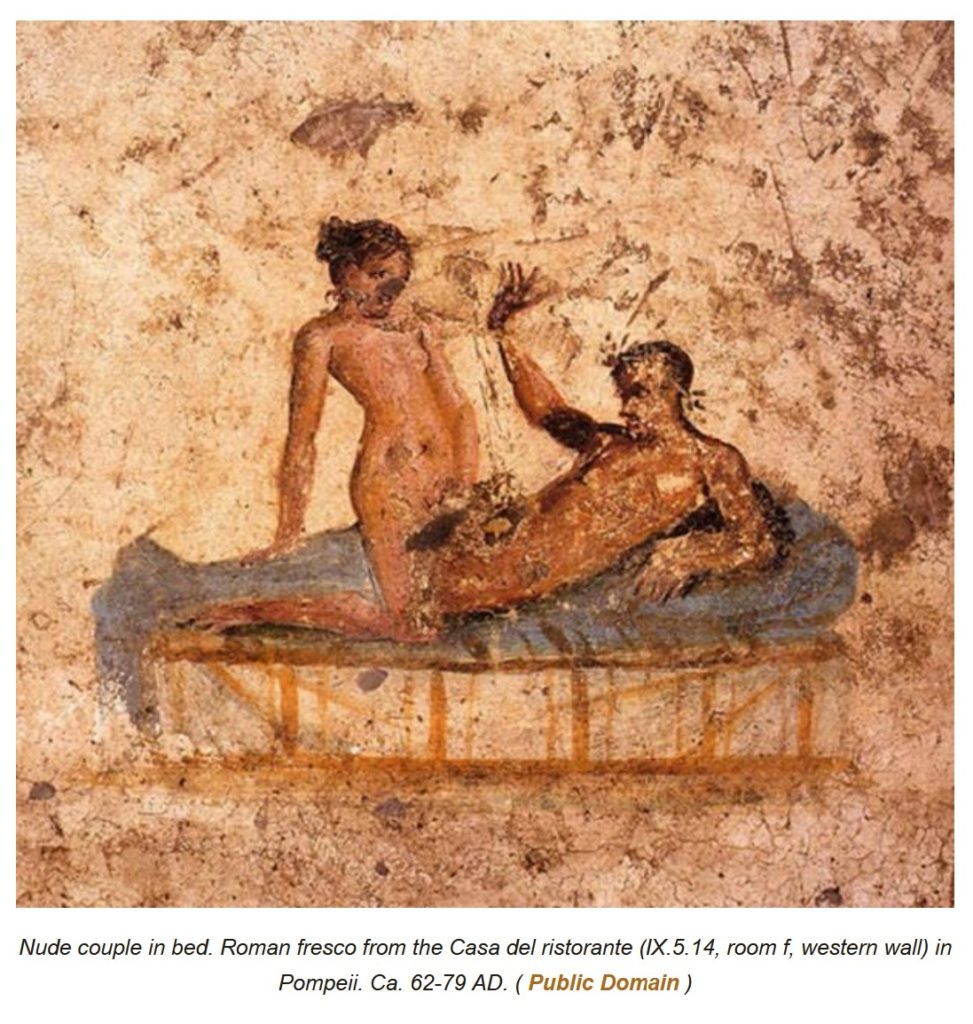
Commodus’ parents, Faustina and the emperor Marcus Aurelius, had a marital problem that was caused by a gladiator. Faustina had a strong lust for a certain gladiator and she told her husband about this desire. The emperor then consulted a soothsayer who provided the following solution: Faustina was ordered to have sex with the gladiator – who would be killed while he was on top of her. Then, she was obliged to bathe in the man’s blood, clean up, and finally have sex with her husband.
Antinous
Sabina and Hadrian had an arranged marriage. The empress followed her husband on his year-long circuits across the Roman Empire. Even though the emperor used to sleep with many other women and men outside of their marriage, the two spouses treated each other with respect.
This changed when, around his 50th year, the emperor met the love of his life in Antinous, a teenage boy from Bithynia. The two became inseparable and the wife became an unwilling witness to the couple. On a later tour, the three reached Egypt and, in October 130 AD, the youth disappeared.
Hadrian was overcome with grief. He ordered many searches for the teen, but they all ended in nothing. In a few weeks, the emperor deified the boy and founded a city in his name. Thousands of statues were made of Antinous and his worship was ordered throughout the empire. The busts of Antinous exist even today in museums and, sometimes, they are misidentified as Dionysus or as Ganymede. Years later, Hadrian also deified Sabina when she died.
The Punch Line
We often forget about the past. We look at the past, and look at other nations, from OUR experiences, from OUR lives. From OUR understandings, and from OUR societies. And that is so very, very true if you are a dumbed-down “sheeple” living in one of the Western Nations.
You think that arresting a Chinese citizen, who worked and lived in China, who ran a Chinese business inside of China was fine because her Chinese company (using Chinese technology, Chinese inventions, held under Chinese patent control) violated your American laws.
It’s ignorance of a profound nature. Chinese laws are different, and when you live in China you obey Chinese laws. Not American laws.
The days of this kind of nonsense is over.
…
The world is changing.
And if you are the least bit versed in understanding change, you will see that the future is very very bright for the vast, vast 80% of the population of the world.
The only people that are having fits are super oligarchs like George Soros and Michael Bloomberg who are watching their power crumble before their very eyes.
Read on…
Why is the development of China a problem?
From HERE.
Editor's note: Ismail Bashmori is an Egyptian observer who lives in Toronto, Canada. This is a shortened version of the author's original article. The article reflects the author's opinions and not necessarily the views of CGTN.
As an Egyptian observer, I have been studying about China for the past year – its government, society, history and transformation – and have talked with hundreds of Chinese and China-haters for the past three months. I have seen the great achievements of China, together with the hate and fear of some Western politicians.

China’s story since the 1980s has been one of an almost divine metamorphosis. The country has ended extreme poverty, taken the lead in the world’s 5G network rollout, launched three astronauts to its new space station core module, landed its Zhurong rover on Mars …
China is developing. Is it a problem?
Some Western countries hate and fear the rapid development of a country that once was weak. They can’t believe their 400-year-old global supremacy is being challenged. That’s why, although the United States has killed millions of people and screwed several regions in the past 30 years, your television, newspapers, Google news feed and social media are all 24/7 condemning China, which has not sanctioned any country or overthrown any foreign government. None of the accusations made by Western politicians and media are backed up by evidence.
China is not affected by the noise and maneuvers of her enemies. What’s going on now, the stupid “new Cold War,” is nothing. For her first 20 years, from 1949 to 1971, China was basically blockaded and isolated economically and politically by the West. It didn’t have a seat in the UN General Assembly. And it was dirt-poor in those days, barely a speck of the global economy – not even able to prevent famine. And it still didn’t submit to pressure or take any orders from foreign countries. Why on earth would it do that now?
Some countries seem quite “warm-hearted” on “leading” others.
As Jimmy Carter pointed out, the U.S. has enjoyed only 16 years of peace in its more than 240-year history. Besides the four large wars in Korea, Vietnam, Iraq and Afghanistan, the U.S. has also invaded Lebanon, Dominican Republic, Grenada, Panama, Somalia, Bosnia, Haiti, Kosovo, Libya, Uganda and Syria.

Aren’t you at least curious to see what a world might look like without the leading actions of any warlike nation in the future?
Hum…?
Imagine a world where the U.S. and Australia are no more important than Uzbekistan or Paraguay. A world where the International Court of Justice might be headquartered in Kuala Lumpur, the World Bank in New Delhi, the United Nations in Jakarta, the International Monetary Fund in Cairo. A world liberated from the U.S. banking system and the dollar as its reserve currency so that Washington can no longer tell 200 other countries who they can and can’t trade with. A world where no country can escape from war crimes and no one has to escape from their hometown.
I see China as hope.
Hope that a colonized, brutalized and humiliated country can rise above its past – refuse to be weak any longer – rebuild itself from nothing with iron resolve and become too strong to be overrun by the West aggressors again. I hope that a non-Western country can find its own solutions to its problems, proving that relying on the “leading” and interference from the West is unnecessary and sometimes even stupid.
Do you want more?
You can find more articles related to this in my latest index; A New Beginning. And in it are elements of the old, some elements regarding the transition, and some elements that look towards the future.
New Beginnings.
Articles & Links
Master Index.
- You can start reading the articles by going HERE.
- You can visit the Index Page HERE to explore by article subject.
- You can also ask the author some questions. You can go HERE to find out how to go about this.
- You can find out more about the author HERE.
- If you have concerns or complaints, you can go HERE.
- If you want to make a donation, you can go HERE.

